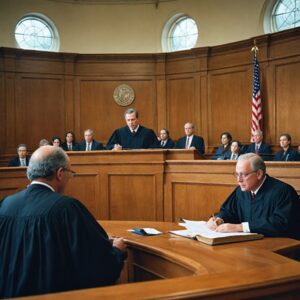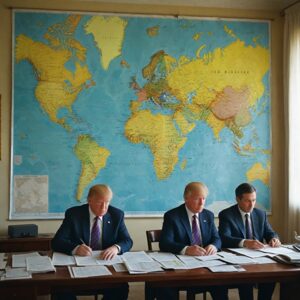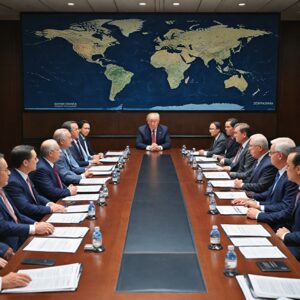Summary
The effort by Pamela Bondi, the 87th United States Attorney General, to release grand jury transcripts and related materials from the Jeffrey Epstein case has been a significant and contentious episode in the pursuit of transparency and accountability in one of the most high-profile investigations of recent years. Bondi, who previously served as Florida’s Attorney General and is known for her focus on human trafficking issues, positioned the release as a fulfillment of former President Donald Trump’s pledge to “lift the veil” on Epstein’s illicit activities and those of his associates. The disclosures included flight logs, contact lists, and partial grand jury testimony, featuring disturbing accounts from victims, but fell short of fully satisfying public and political demands for comprehensive evidence.
The push for unsealing Epstein’s grand jury transcripts was supported by legislative actions, notably Florida Governor Ron DeSantis’s signing of a law allowing limited public access to such records, but remained subject to strict federal court oversight, particularly in the Southern District of New York, where Epstein faced federal charges before his 2019 death. The legal framework governing grand jury secrecy, established by Supreme Court precedent and varied state laws, grants courts broad discretion to withhold or release transcripts, balancing interests in protecting investigation integrity with demands for justice and transparency.
Bondi’s handling of the case sparked considerable controversy. While she publicly committed to transparency, critics accused her of engaging in political theater and of releasing incomplete information that failed to fully expose Epstein’s network or clarify conspiracy theories surrounding his death and potential protection of powerful figures. Her alignment with Trump and partisan tensions further complicated perceptions of her role, drawing both staunch support and sharp criticism across the political spectrum.
The case underscores the complex interplay between legal standards, political pressures, and public interest in the disclosure of sensitive grand jury materials. Bondi’s efforts, while notable for advancing partial transparency, highlight ongoing challenges in balancing confidentiality and accountability in high-profile criminal investigations involving influential individuals.
Background
In early 2023, Attorney General Pamela Bondi initiated efforts to release grand jury transcripts and related materials from the Jeffrey Epstein case, aiming to usher in a new era of transparency at the Justice Department. Bondi publicly emphasized the administration’s commitment to exposing Epstein’s actions and those of his associates, describing the release as a fulfillment of President Trump’s pledge to bring greater openness to the case. The release included Epstein’s planes, contact information for hundreds of associates, and brief descriptions of items found at his residences, though critics characterized the initial document dump as largely political theater.
The push to unseal the transcripts was supported by legislative action, notably by Florida Governor Ron DeSantis, who signed legislation in February that created a narrow exemption allowing the records to be unsealed on July 1. The transcripts contain disturbing testimony, including that of a then-16-year-old girl who was initially 14 when she first encountered Epstein. She testified that she was told to claim she was 18 and described being paid to give Epstein massages, with escalating inappropriate conduct detailed in her account.
Despite these efforts, the scope and extent of the administration’s request to unseal the grand jury materials remained unclear, as such release requires approval from a federal judge in the Southern District of New York, where Epstein was charged prior to his 2019 death by suicide. The Justice Department and the FBI previously issued a memo stating no evidence was found that Epstein maintained a “client list” or blackmailed prominent individuals, which fueled public speculation and conspiracy theories about potential government concealment to protect powerful figures linked to Epstein.
Legal precedents and procedures regarding grand jury transcripts also factored into the discussion. The Supreme Court has emphasized the defense’s right to access grand jury proceedings transcripts, but current law does not regard failure to produce such records as reversible error if no record exists. Typically, grand jury transcripts and notes remain under government control and are not publicly released unless a court orders otherwise. Moreover, concerns about the nature of the evidence—much of which included child sexual abuse material—were cited by Bondi in defending the decision to withhold most of the video evidence from the public, though demands for greater transparency persisted among both political supporters and opponents.
These developments reignited longstanding questions and controversies surrounding Epstein’s case, the completeness of the publicly available evidence, and the role of federal authorities in managing the sensitive information tied to Epstein and his extensive network.
Attorney General Bondi
Pamela Jo Bondi, the 87th United States Attorney General since 2025 and former 37th Attorney General of Florida, has played a prominent role in the release of Jeffrey Epstein’s grand jury transcripts. As Florida’s top prosecutor from 2011 to 2019, Bondi was known for her focus on human trafficking issues and for urging stricter state laws against traffickers. Her tenure as U.S. Attorney General has been marked by a commitment to transparency, particularly concerning high-profile cases such as Epstein’s.
Bondi publicly emphasized the Department of Justice’s dedication to unveiling the illicit activities of Epstein and his co-conspirators. She described the release of the grand jury records as a pivotal step toward transparency and justice, framing it as a fulfillment of President Trump’s commitment to shedding light on the “disgusting actions” associated with the case. Bondi herself previewed the release on Fox News, characterizing it as “breaking news,” though some critics viewed the timing and presentation as politically motivated theater.
The transcripts aligned with evidence previously made available by the Palm Beach County State Attorney’s Office, offering detailed testimony from victims and witnesses, including accounts of young women recruited in high school to provide massages to Epstein. The public disclosure aimed to provide closure to Epstein’s victims and reassurance to the community, a goal underscored by statements from officials such as Palm Beach County Clerk of the Circuit Court and Comptroller, who pledged to ensure no relevant records remained sealed.
Bondi’s role in this release is consistent with her broader political profile as a staunch ally of former President Donald Trump. Having served as one of Trump’s defense attorneys during his first impeachment trial and working within Trump-aligned institutions, Bondi’s actions reflect a blend of legal authority and political loyalty. Her tenure as Attorney General has often intersected with politically charged issues, including her support for Trump’s hardline policies and efforts to scrutinize career prosecutors and FBI agents involved in investigations of the former president.
In sum, Attorney General Bondi’s leadership in making the Jeffrey Epstein grand jury transcripts public represents a notable episode in her career, highlighting her focus on victims’ rights, transparency, and alignment with the Trump administration’s agenda.
Involvement in Epstein Grand Jury Transcripts Release
Pamela J. Bondi, as Attorney General, played a prominent role in the effort to release grand jury transcripts related to the Jeffrey Epstein child sex trafficking investigation. Bondi publicly emphasized the Department of Justice’s commitment to transparency in the case, framing the release of documents as part of fulfilling President Trump’s pledge to “lift the veil” on Epstein’s network and hold perpetrators accountable. She described the initial release of files, which included information on Epstein’s associates and assets, as a significant step toward public accountability, although critics argued that the materials released were limited and failed to satisfy demands for full disclosure.
Despite Bondi’s advocacy, the legal and procedural barriers to releasing grand jury transcripts posed substantial challenges. Federal rules generally mandate secrecy of grand jury proceedings, with only narrow exceptions permitting disclosure. Courts have broad discretion in determining whether to unseal such materials, often requiring a showing that disclosure is necessary to prevent injustice in other judicial proceedings and that the public interest outweighs the need for secrecy. These restrictions complicated the Justice Department’s efforts to make the transcripts public, particularly in the New York jurisdiction where Epstein was investigated.
Bondi faced pressure both from within the administration and from Congress to produce additional evidence, including videos and extensive investigative files. She defended decisions not to release certain materials, citing concerns over the nature of evidence such as child sexual abuse material, which is protected and sensitive. The limited release was criticized by some political figures and advocates who viewed it as insufficient transparency, leading to ongoing debates about the scope and timing of further disclosures.
Ultimately, Bondi’s role highlighted the tension between the Department of Justice’s statutory obligation to protect grand jury secrecy and the political and public demands for transparency in a high-profile case involving Jeffrey Epstein. The decision-making process underscored the complexities courts face in balancing these competing interests when considering motions to unseal grand jury transcripts and related materials.
Legal Arguments and Court Filings
The legal discourse surrounding the release of grand jury transcripts in the Jeffrey Epstein case highlights the tension between the public’s right to access court records and the long-standing principle of grand jury secrecy. The Supreme Court has underscored the importance of access to grand jury transcripts for the defense, emphasizing that defendants cannot be disadvantaged if grand jury proceedings remain unrecorded or undisclosed. However, the Court also recognizes that disclosure is subject to judicial discretion, particularly concerning the conditions and circumstances under which transcripts may be released, including whether defendants bear the cost of obtaining such records.
Rules governing court records, such as New Mexico Rules of Appellate Procedure (NMRA) Rule 1-079 and Rule 5-123, provide a presumption of public access to court documents, including trial records and transcripts, unless sealed by court order or protected under specific provisions. Notably, some court records—such as grand jury proceedings where a no-bill has been filed—are automatically sealed without requiring a motion or order. Any sealing order must specify who is entitled to notice of future motions to unseal or modify the order, ensuring procedural transparency.
Judicial precedent and local court rules also shape the availability of grand jury materials. The D.C. Circuit has rejected media efforts to establish a public docket for grand jury ancillary proceedings, reinforcing that public docketing is not mandatory and that access is limited to specific court rules, such as Local Criminal Rule 6.1. This rule mandates that filings related to grand jury subpoenas be under seal but permits courts to unseal documents if continued secrecy is deemed unnecessary to protect grand jury matters. For example, Chief Judge Beryl Howell partially granted a motion to unseal records in a contempt proceeding linked to the Special Counsel’s grand jury investigation into the Trump campaign’s Russian ties.
Federal courts balance the need for grand jury secrecy against the public interest in disclosure, with no presumptive First Amendment or common law right to access grand jury documents established by the Third Circuit. The decision to release grand jury transcripts is therefore left to judicial discretion, with courts considering whether the original court is best positioned to assess the propriety of disclosure and weighing the competing interests accordingly. Access to state grand jury transcripts varies by jurisdiction, further complicating the legal landscape for public disclosure requests.
Judicial Responses and Procedural History
The judicial handling of the grand jury transcripts related to Jeffrey Epstein’s case has been marked by cautious procedural considerations and competing interests between secrecy and public disclosure. Under federal criminal procedure rules, grand jury transcripts are generally kept confidential, with limited and narrowly defined exceptions for disclosure. Courts maintain discretion over whether to release such records, often weighing the need to protect the integrity of the grand jury process against demands for transparency.
In Florida, a judge ordered the surprise release of graphic transcripts from the state’s 2006 prosecution of Epstein, which had previously culminated in a lenient plea deal for the financier. This release was notable due to the public and political pressure for greater openness in the case. Conversely, in New York, where Epstein faced child sex trafficking charges in 2019, the Justice Department has encountered difficulty convincing a federal judge to release the grand jury transcripts, reflecting the judiciary’s cautious approach to maintaining grand jury secrecy absent compelling justification.
The courts have underscored that the decision to disclose grand jury materials must be based on the court’s informed judgment, often influenced by factors such as the defendant’s rights, the public interest, and the procedural posture of the case. The judiciary typically retains control over the circumstances of any disclosure, including whether defendants may obtain transcripts at government expense or whether recordings, if any, should be released. Additionally, appellate courts have confirmed that there is no presumptive First Amendment or common law right of access to grand jury proceedings, leaving release decisions firmly within judicial discretion.
Public and political figures have sought to influence the process. Former President Donald Trump called on Attorney General Pam Bondi to produce “any and all pertinent Grand Jury testimony,” subject to court approval, related to the Epstein case. Bondi publicly expressed readiness to move the court to unseal the transcripts, reflecting a concerted push for transparency.
Procedurally, courts handling motions to unseal grand jury records specify notice requirements for parties entitled to object or respond to such motions. Rules governing court records generally presume public access unless specifically sealed by court order or otherwise protected, reinforcing the principle that judicial transparency is the default stance unless compelling reasons justify secrecy. This procedural framework continues to shape the evolving discourse surrounding the Epstein grand jury materials.
Legal Standards and Precedents for Unsealing Grand Jury Transcripts
Grand jury proceedings are generally shrouded in secrecy to protect the integrity of the investigation and the privacy of those involved. This confidentiality extends to witness testimony, evidence presented, and transcripts of the proceedings themselves, as established in case law such as People v. Thompson, where courts recognized the broad scope of grand jury secrecy to prevent disclosure of what transpired before the grand jury.
Statutes and court rules across various jurisdictions underscore the presumption of secrecy. For example, New Mexico law requires that grand jury records be confidential and prohibits transcription or public release unless a district court orders otherwise for good cause, such as prosecuting a witness for perjury. Similarly, Florida law explicitly forbids releasing notes, records, and transcripts of grand jury proceedings, and local rules in the District of Columbia mandate that motions and related papers concerning grand jury subpoenas be filed under seal, with the court retaining discretion to lift secrecy if continued confidentiality is no longer necessary.
The standard for breaking grand jury secrecy is deliberately stringent. Courts require that parties seeking disclosure demonstrate that the material is essential to prevent a possible injustice in another judicial proceeding and that the need for disclosure outweighs the interest in maintaining secrecy. Additionally, requests must be narrowly tailored to cover only the material necessary for that purpose. The Third Circuit has emphasized there is no presumptive First Amendment or common law right of access to grand jury materials, leaving the decision to release such records to the court’s discretion[United States v. Smith, 123 F.3d 140 (3d Cir. 1997)].
Access to grand jury transcripts is particularly critical to the defense in criminal proceedings. The Supreme Court has underscored the importance of defendants having access to grand jury transcripts, recognizing that without recorded proceedings, defendants are at a disadvantage. This principle has influenced the federal procedural rules and commentary advocating for recording grand jury testimony to ensure fairness.
In the context of court records more broadly, rules such as New Mexico’s Rule 1-079 and Rule 5-123 NMRA provide that court records—including documents, exhibits, transcripts, and docket entries—are presumptively accessible to the public unless sealed by court order. However, certain categories, including grand jury proceedings where no indictment has been returned (a “no bill”), are automatically sealed without the need for a court order. This reinforces the notion that grand jury records enjoy a heightened level of protection relative to other court materials.
Content and Significance of the Grand Jury Transcripts
The grand jury transcripts in the Jeffrey Epstein case contain testimonies and evidence presented during the investigation, including accounts from witnesses such as a 16-year-old girl who detailed interactions with Epstein starting when she was 14 years old. In her testimony, she described being instructed to falsely claim she was 18 and recounted being paid to give Epstein massages while partially undressed, with further inappropriate conduct described during these encounters. These transcripts represent only a portion of the overall evidence compiled by prosecutors and the
Public and Political Reactions
The announcement by Attorney General Pamela Bondi regarding the release of Jeffrey Epstein’s flight logs, contact lists, and grand jury transcripts prompted a wide range of public and political responses. Many critics expressed disappointment, as they had anticipated that the documents would disclose new, significant information about powerful individuals associated with Epstein, but the released materials largely failed to meet these expectations. Conservative influencers were notably given early access to the files before the public release, fueling speculation about selective transparency.
Bondi defended the decision to withhold most of the video evidence, citing concerns that much of it contained child sexual abuse material, which would necessitate careful handling and limit public dissemination. Despite this explanation, pressure mounted from various political quarters, including both Republican and Democratic members of Congress, who explored legislative measures to compel the Department of Justice and the FBI to disclose more of the Epstein-related files and videos. The limited disclosure and the handling of the documents intensified demands for transparency, especially among supporters of former President Donald Trump, who viewed the case through the lens of broader allegations against the so-called “deep state”.
Former President Trump publicly supported Bondi’s handling of the case, praising her efforts and urging her and FBI Director Kash Patel to prioritize other issues such as voter fraud and election integrity, which he considered more urgent. Meanwhile, legal experts and law enforcement officials familiar with Epstein and Ghislaine Maxwell’s cases indicated that they were unaware of the extensive video evidence Bondi described, noting that such materials had not surfaced in indictments or detention memoranda. Court filings in 2023 revealed that Epstein’s estate had located unspecified videos and photos potentially containing child sexual abuse material, suggesting there might be undisclosed evidence.
In response to the ongoing debate, Florida Governor Ron DeSantis signed legislation enabling the partial unsealing of Epstein’s records, leading to the release of transcripts that included disturbing testimony from a minor victim who recounted her interactions with Epstein, highlighting the gravity of the crimes involved. Throughout the process, Bondi emphasized the Department of Justice’s commitment to transparency and to exposing Epstein and his co-conspirators’ misconduct, framing the release as part of fulfilling President Trump’s promise to reveal the truth behind the case. However, legal constraints such as grand jury secrecy rules and Florida statutes continued to limit the extent of public disclosure, maintaining a degree of confidentiality around the most sensitive materials.
Controversies and Criticism
Pam Bondi’s efforts to release grand jury transcripts and related information in the Jeffrey Epstein case generated significant controversy and criticism. While Bondi publicly committed to transparency—pledging to “produce any and all pertinent Grand Jury testimony, subject to Court approval”—her actions were viewed by some as falling short of broader demands for full disclosure. Critics noted that the release focused primarily on testimony presented in federal court, rather than the complete investigative files held by the Justice Department and the FBI, which some congressional Republicans had urged to be made public.
Bondi’s announcement was met with mixed reactions. For example, Senator Mike Lee (R-Utah) described the move as “HUGE” but expressed hope that it would be only the initial step toward greater transparency. Nevertheless, some observers characterized the partial disclosure as largely symbolic or political theater, questioning the substance behind the highly publicized releases and the timing of Bondi’s statements, including her teasing of a “client list” of Epstein’s associates during a February Fox News interview.
Furthermore, Bondi faced backlash from both political opponents and some within her own party. She admonished “weaklings” and “foolish Republicans” who gave attention to the Epstein case, suggesting that some of her supporters had been “duped” by Democrats into amplifying the story. This stance added to tensions, as the Epstein case had become a focal point for conspiracy theories, especially among supporters of former President Donald Trump who doubted the official account of Epstein’s death and sought evidence to implicate influential figures.
The broader issue of grand jury secrecy also contributed to controversy. Legal standards generally maintain strict confidentiality around grand jury proceedings to protect the integrity of investigations, limiting access to transcripts and evidence unless strict criteria are met to prevent injustice. Critics argued that Bondi’s limited disclosures did not fully address these concerns or satisfy public demand for transparency, fueling further speculation and distrust about potential concealment of information to shield powerful individuals connected to Epstein.
Legacy and Impact
Pam Bondi’s efforts to push for the release of grand jury transcripts related to the Jeffrey Epstein case marked a notable moment in the ongoing debate over transparency and accountability in high-profile investigations. The Justice Department’s eventual release of documents, including Epstein’s planes and contact information for numerous associates, was promoted as a new era of openness. However, critics viewed the initial disclosures as largely symbolic and political theater rather than a substantive unveiling of previously hidden evidence.
Bondi’s stance garnered mixed reactions. While some members of the public and political commentators accused her of failing to fully commit to releasing all incriminating files, her position was publicly supported by influential figures who emphasized her job security and rebuffed calls for her resignation from within Trump’s political base. This support underscored the complex interplay between political loyalty and public demand for transparency in sensitive legal matters.
In the broader context, the handling of the Epstein case and related grand jury materials highlighted the legal intricacies governing access to such records. State laws and court rules vary, with many jurisdictions maintaining strict confidentiality of grand jury proceedings to protect witness testimony and the integrity of investigations. For example, in New Mexico, grand jury notes and transcriptions are typically destroyed if no indictment is issued, unless a judge orders their preservation for specific reasons such as perjury prosecution. Federal courts also emphasize judicial discretion in determining when grand jury records may be disclosed, balancing the need for secrecy with defendants’ rights to a fair trial and the public’s interest.
Ultimately, Bondi’s push contributed to ongoing discussions about the limits of transparency, the politicization of legal processes, and the challenges of balancing confidentiality with public accountability in cases involving powerful individuals. Her involvement remains a reference point in debates over the appropriate release of sensitive legal documents and the role of political considerations in justice administration.


























